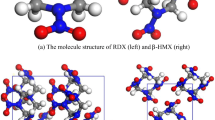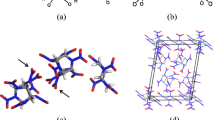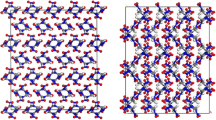Abstract
Molecular dynamics (MD) simulation was conducted to research the effect of molar ratios for α/β-HMX, γ/β-HMX, and δ/β-HMX(octahydro-1,3,5,7-tetranitro-1,3,5,7-tetrazocine) mixture systems on thermal stability, sensitivity, and mechanical properties of explosives, and the computing models were established by Materials Studio (MS). The binding energies, the maximum trigger bond length (LN–NO2), cohesive energy density as well as mechanical properties of the mixture systems and the pure β-HMX crystal were obtained and contrasted. The results demonstrate that the molar ratios have great influence on the binding capacity of molecules between α, γ, δ-HMX, and β-HMX in the mixture systems. The binding energies decrease with the increase of molecular molar ratio and have the maximum values at the 1:1 M ratio. The maximum trigger bond length does not change apparently after mixing, while the cohesive energy density (CED) increases as the molar ratio increases but are all smaller than the pure β-HMX crystal, demonstrating that the sensitivity of the mixture systems increases. The mechanical properties decrease after mixture, which illustrates that the mechanical properties of the pure crystal are superior to the mixture systems.





Similar content being viewed by others
References
Liu J, Hao G, Rong Y, Xiao L, Jiang W, Li F, Jing C, Gao H, Chen T, Ke X (2017) Application and properties of nanometric HMX in PBX. Combust Explos Shock Waves 53:744–749
Xiong SL, Chen SS, Jin SH, Zhang Z, Zhang Y, Li LJ (2017) Molecular dynamic simulations on TKX-50/HMX cocrystal. RSC Adv 7:6795–6799
Myint PC, Nichols AL (2017) Thermodynamics of HMX polymorphs and HMX/RDX mixtures. Ind Eng Chem Res 56:387–403
Li YX, Chen SS, Ren FD, Jin SH (2017) Theoretical insight into the influence of molecular ratio on the stability, mechanical property, solvent effect and cooperativity effect of HMX/DMI cocrystal explosive - theoretical insight into the influence of molecular ratio on the stability, mechanical property, solvent effect and cooperativity effect of HMX/DMI cocrystal explosive. Chin J Struct Chem 36:562–574
Liu YZ, Lai WP, Ma YD, Yu T, Kang Y, Ge ZX (2017) Face-dependent solvent adsorption: a comparative study on the interfaces of HMX crystal with three solvents. (Report) J Phys Chem B 121:7140–7146
Song KP, Ren FD, Zhang SH, Shi WJ (2016) Theoretical insights into the stabilities, detonation performance, and electrostatic potentials of cocrystals containing α- or β-HMX and TATB, FOX-7, NTO, or DMF in various molar ratios. J Mol Model 22:1–15
Wang X, Xiao J (2017) Molecular dynamics simulation studies of the ε-CL-20/HMX co-crystal-based PBXs with HTPB. Struct Chem 28:1645–1651
Sun T, Xiao JJ, Liu Q, Zhao F, Xiao HM (2014) Comparative study on structure, energetic and mechanical properties of a ε-CL-20/HMX cocrystal and its composite with molecular dynamics simulation. J Mater Chem A 2:13898
Yan T, Wang JH, Liu YC, Zhao J, Yuan JM, Guo JH (2015) Growth and morphology of 1,3,5,7-tetranitro-1,3,5,7-tetraazacy-clooct ane (HMX) crystal. J Cryst Growth 430:7–13
Hang GY, Yu WL, Wang T, Li Z (2016) Determination of the effects of water adsorption on the sensitivity and detonation performance of the explosive JOB-9003 by molecular dynamics simulation. J Mol Model 22:1–8
Guo YN, Wang YL (2017) Effects of air humidity on properties of JO-9159 explosive by molecular dynamics simulation. Key Eng Mater 727-727:455–460
Han G, Li QF, Gou RJ, Zhang SH, Ren FD, Wang L, Guan R (2017) Growth morphology of CL-20/HMX cocrystal explosive: insights from solvent behavior under different temperatures. J Mol Model 23:1–10
Cady HH, Larson AC, Cromer DT (1963) The crystal structure of α-HMX and a refinement of the structure of β-HMX. Acta Cryst 16:617–623
Choi CS, Boutin HP (1970) A study of the crystal structure of β-cyclotetramethylene tetranitramine by neutron diffraction. Acta Crystallogr Sect B 26:1235–1240
Gitany R, Anderson GD, McEwen RS (1974) The crystal and molecular structure of pseudoivalin bromoacetate. Acta Crystallogr Sect B 30:1900–1904
Main P, Cobbledick RE, Small RWH (1985) Structure of the fourth form of 1,3,5,7-tetranitro-1,3,5,7-tetraazacyclooctane (γ-HMX), 2C4H8N8O8.0.5H2O. Acta rystallogr Sect C Crysta Struct Commun 41:1351–1354
Han G, Gou RJ, Ren FD, Zhang SH, Wu CL, Zhu SF (2017) Theoretical investigation into the influence of molar ratio on binding energy, mechanical property and detonation performance of 1,3,5,7-tetranitro-1,3,5,7-tetrazacyclo octane (HMX)/1-methyl-4,5-dinitroimidazole (MDNI) cocrystal explosive. Comput Theor Chem 1109:27–35
Sun H (1998) COMPASS: an ab initio force-field optimized for condensed-phase applications - overview with details on alkane and benzene compounds. J Phys Chem B 102:7338
McQuaid MJ, Sun H, Rigby D (2004) Development and validation of COMPASS force field parameters for molecules with aliphatic azide chains. J Comput Chem 25:61–71
Li YX, Chen SS, Ren FD (2015) Theoretical insights into the structures and mechanical properties of HMX/NQ cocrystal explosives and their complexes, and the influence of molecular ratios on their bonding energies. J Mol Model 21:1–12
Wei YJ, Ren FD, Shi WJ, Zhao Q (2016) Theoretical insight into the influences of molecular ratios on stabilities and mechanical properties, solvent effect of HMX/FOX-7 cocrystal explosive. J Energ Mater 34:426–439
Qiu L, Xiao HM (2009) Molecular dynamics study of binding energies, mechanical properties, and detonation performances of bicyclo-HMX-based PBXs. J Hazard Mater 164:329–336
Andersen HC (1980) Molecular dynamics simulations at constant pressure and/or temperature. J Chem Phys 72:2384–2393
Berendsen HJC, Postma JPM, van Gunsteren WF, Dinola A, Haak JR (1984) Molecular dynamics with coupling to an external bath. J Chem Phys 81:3684–3690
Allen MP (1987) Computer simulation of liquids. Clarendon Press, Oxford
Ewald PP (1921) Calculation of optic and electrostatic lattice potential. Ann Phys 64:253–287
Palmer SJP, Field JE, Huntley JM (1993) Deformation, strengths and strains to failure of polymer bonded explosives. Proc Royal Soc: Math Phys Sci (1990–1995) 440:399–419
Xiao JJ (2013) Molecular dynamics of energetic materials. Science Press Beijing, Beijing
Xiao JJ, Wang WR, Chen J, Ji GF, Zhu W, Xiao HM (2012) Study on structure, sensitivity and mechanical properties of HMX and HMX-based PBXs with molecular dynamics simulation. Comput Theor Chem 999:21–27
Pospíšil M, Vávra P, Concha M, Murray J, Politzer P (2010) A possible crystal volume factor in the impact sensitivities of some energetic compounds. J Mol Model 16:895–901
Liu Y, Gong X, Wang L, Wang G, Xiao H (2011) Substituent effects on the properties related to detonation performance and sensitivity for 2,2′,4,4′,6,6′-hexanitroazobenzene derivatives. J Phys Chem A 115:1754
Weiner JH, Milstein F (1984) Statistical mechanics of elasticity. J Appl Mech 51:707
Wu JL (1993) Mechanics of elasticity. Tongji University Press, Shanghai
Pugh SF (1954) XCII. Relations between the elastic moduli and the plastic properties of polycrystalline pure metals. London, Edinburgh, Dublin Philos Mag J Sci 45:823–843
Watt JP, Davies GF, O’Connell RJ (1976) The elastic properties of composite materials. Rev Geophys 14:541–563
Grimme S (2006) Semiempirical GGA-type density functional constructed with a long-range dispersion correction. J Comput Chem 27:1787–1799
Parrinello M, Rahman A (1982) Strain fluctuations and elastic constants. J Chem Phys 76:2662–2666
Xu XJ, Xiao HM, Xiao JJ, Zhu W, Huang H, Li JL (2006) Molecular dynamics simulations for pure epsi-CL-20 and epsi-Cl-20-based PBXs. J Phys Chem B 110:7203–7207
Pettifor DG (1992) Theoretical predictions of structure and related properties of intermetallics. Mater Sci Technol 8:345–349
Hang GY, Yu WL, Wang T, Wang JT, Li Z (2017) Theoretical insights into the effects of molar ratios on stabilities, mechanical properties, and detonation performance of CL-20/HMX cocrystal explosives by molecular dynamics simulation. J Mol Model 23:30
Acknowledgments
This research is supported by the National Natural Science Foundation of China under grant No.U1730244, No.11775195, and No.11405152. We also would like to acknowledge the Project from the China Academy of Engineering Physics No.ESHT-KY-2015-71. The calculation resources in the Simulation Center of CAEP are appreciated.
Author information
Authors and Affiliations
Corresponding author
Additional information
Publisher’s note
Springer Nature remains neutral with regard to jurisdictional claims in published maps and institutional affiliations.
Appendix
Appendix
The density of different mixture system:
α/β-HMX mixture:

2γ/β-HMX mixture:

δ/β-HMX mixture:

Rights and permissions
About this article
Cite this article
Shi, YB., Bai, LF., Liu, BQ. et al. Theoretical investigation into the influence of molar ratio on mixture system: α, γ, δ-HMX molecules coexisting with β-HMX crystal. J Mol Model 25, 213 (2019). https://doi.org/10.1007/s00894-019-4097-1
Received:
Accepted:
Published:
DOI: https://doi.org/10.1007/s00894-019-4097-1




